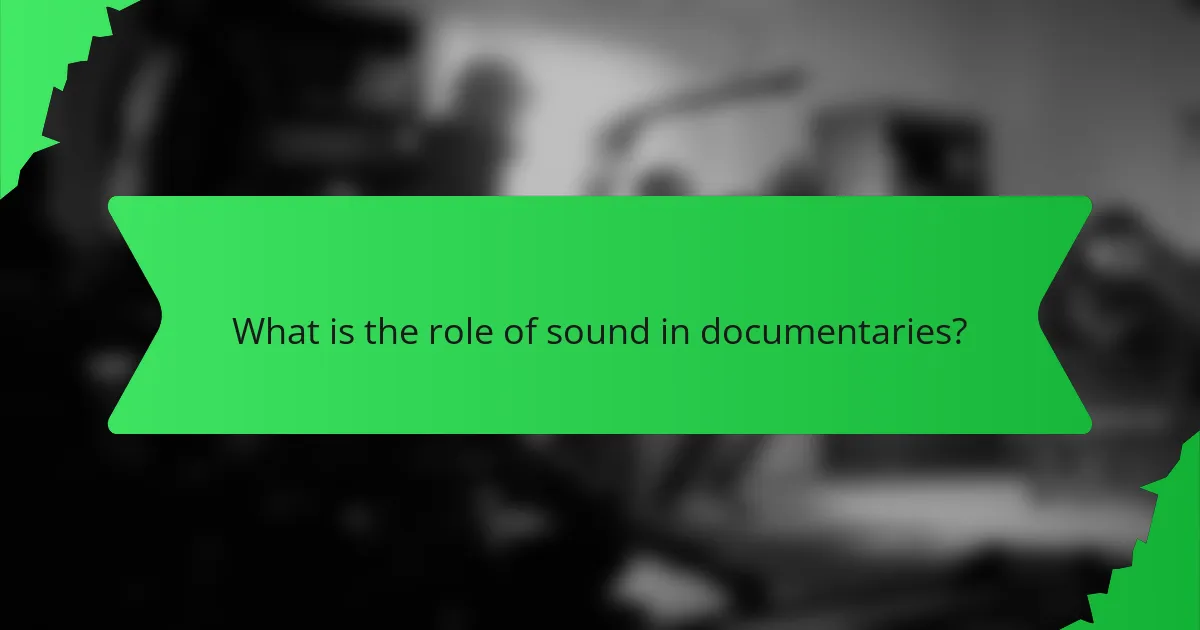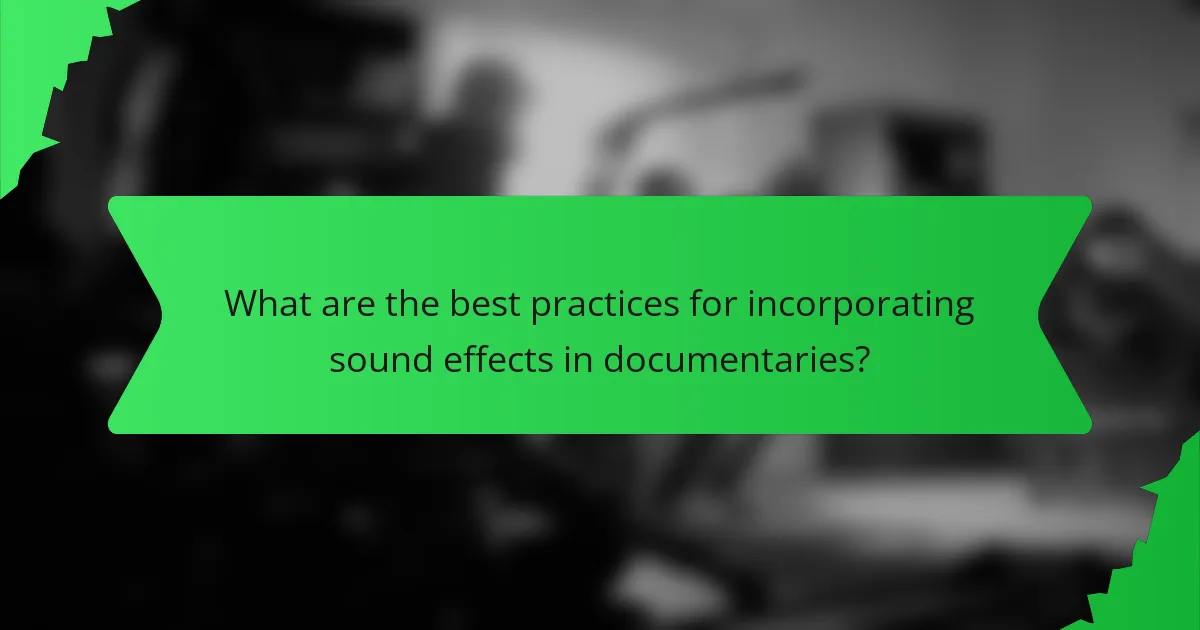Sound is a critical element in documentaries, encompassing music selection, sound effects, and voiceovers that enhance storytelling and emotional engagement. Effective sound design enriches the viewing experience by providing context, atmosphere, and realism, while music is carefully chosen to align with the documentary’s themes and evoke specific emotions. The use of sound effects complements visuals and reinforces narratives, ensuring clarity and impact through high-quality audio. Research indicates that strategic sound design can significantly improve viewer retention and understanding, highlighting its essential role in shaping the overall effectiveness of documentary films.

What is the role of sound in documentaries?
Sound plays a crucial role in documentaries by enhancing storytelling and emotional engagement. It provides context and atmosphere, helping to immerse viewers in the subject matter. Sound effects can emphasize actions and create a sense of realism. Music selection can set the tone and evoke specific emotions throughout the narrative. Voiceovers guide the audience, offering insights and clarifying information. According to a study by the University of Southern California, effective sound design significantly improves viewer retention and understanding. This demonstrates the importance of sound in shaping the overall impact of a documentary.
How does sound influence the storytelling in documentaries?
Sound significantly influences storytelling in documentaries by enhancing emotional engagement and narrative clarity. Music selection sets the tone and mood, guiding viewer emotions. Sound effects create immersive environments, making scenes feel more authentic. Voiceovers provide context, helping to convey complex ideas succinctly. Research indicates that sound elements can increase viewer retention and understanding. For instance, a study published in the Journal of Media Psychology found that documentaries with well-integrated sound enhance audience connection to the material. Thus, sound is essential in shaping the overall narrative experience in documentaries.
What are the key elements of sound that contribute to documentary narratives?
Key elements of sound that contribute to documentary narratives include music, sound effects, and voiceovers. Music sets the emotional tone and enhances the storytelling. It can evoke feelings and connect audiences to the subject matter. Sound effects provide realism and context, enriching the viewer’s experience. They help to create a sense of place and time. Voiceovers deliver essential information and guide the narrative. They can convey the filmmaker’s perspective or provide commentary. Together, these elements work to engage the audience and deepen their understanding of the documentary’s themes.
How does sound enhance emotional engagement in documentary films?
Sound enhances emotional engagement in documentary films by creating an immersive experience. It establishes mood and atmosphere, guiding the audience’s emotional response. For instance, music can evoke feelings of sadness or joy, depending on its tempo and harmony. Sound effects add realism, making scenes more impactful and relatable. Voiceovers provide context and intimacy, allowing viewers to connect with the subjects. Research shows that documentaries utilizing effective sound design can increase viewer empathy and retention of information. Studies indicate that emotional responses are heightened when sound complements visual storytelling.
What types of sound are commonly used in documentaries?
Documentaries commonly use three types of sound: voiceovers, sound effects, and music. Voiceovers provide narration that guides the audience through the content. They help convey information and context, enhancing understanding. Sound effects add realism and immersion, making scenes more engaging. They can include ambient sounds, animal noises, or specific actions. Music sets the emotional tone of a documentary. It can evoke feelings and enhance the narrative. Each sound type plays a crucial role in storytelling, contributing to the overall impact of the documentary.
What is the importance of music selection in documentaries?
Music selection in documentaries is crucial for enhancing emotional impact. It sets the tone and mood, guiding audience reactions. For example, uplifting music can evoke hope, while somber tones may underscore tragedy. Research indicates that music influences viewer engagement and retention of information. A study by the University of California found that documentaries with well-chosen music have higher audience satisfaction ratings. Additionally, music can create a sense of continuity and coherence in storytelling. It helps to bridge scenes and maintain viewer interest. Overall, thoughtful music selection is essential for effective documentary filmmaking.
How do sound effects contribute to the realism of a documentary?
Sound effects enhance the realism of a documentary by creating an immersive auditory environment. They provide context and depth to visual elements. For instance, the sound of footsteps can ground a scene in reality. Background noises, like wildlife or urban sounds, add authenticity to the setting. Research indicates that sound effects can evoke emotional responses, making the audience feel more connected. Effective sound design helps to convey the atmosphere and mood of the documentary. This can influence how viewers perceive the narrative and characters. Overall, sound effects are crucial for achieving a believable and engaging documentary experience.
What role do voiceovers play in conveying information in documentaries?
Voiceovers play a crucial role in conveying information in documentaries. They provide narration that guides viewers through the content. This narration helps to contextualize visuals and enhance storytelling. Voiceovers can clarify complex subjects, making them more accessible to the audience. They also add emotional depth, influencing how viewers perceive the information. Furthermore, voiceovers can establish a consistent tone and pacing throughout the documentary. Research indicates that effective voiceovers improve viewer engagement and retention of information. For instance, studies show that audiences remember facts better when accompanied by a well-delivered voiceover.

How is music selected for documentaries?
Music for documentaries is selected based on thematic relevance and emotional impact. Filmmakers analyze the documentary’s subject matter to find music that enhances the narrative. They often consider the tone and mood they wish to convey. Additionally, they may use existing scores or commission original pieces. The selection process includes testing music with scenes to gauge audience reactions. Music licensing and rights management also play crucial roles in the selection process. Ultimately, the goal is to create an auditory experience that complements the visual storytelling. This approach helps engage viewers and deepen their connection to the content.
What factors influence the choice of music in documentary filmmaking?
The choice of music in documentary filmmaking is influenced by several key factors. Emotional tone is crucial; music sets the mood and enhances viewer engagement. The subject matter also plays a significant role; specific genres may resonate better with particular themes. Audience demographics influence music selection; filmmakers consider what will appeal to their target viewers. Cultural context is important; music can reflect the setting and background of the documentary. Licensing and budget constraints affect choices; not all music is available for use without significant cost. Lastly, the filmmaker’s personal style and vision guide the selection process; unique preferences can shape the overall soundscape.
How does the genre of a documentary affect music selection?
The genre of a documentary significantly influences music selection. Different genres evoke distinct emotions and themes. For example, nature documentaries often use orchestral music to enhance awe and wonder. In contrast, historical documentaries may incorporate period-specific music to create authenticity.
The tone of the documentary genre also dictates the style of music. A serious documentary might feature somber, minimalist compositions. Conversely, a light-hearted documentary could utilize upbeat, playful tracks.
Research shows that music can shape audience perception and engagement. A study published in the Journal of Media Psychology found that music congruence with documentary content enhances viewer experience. Thus, the genre effectively guides the choices made in music selection to align with the intended message and emotional impact.
What are the legal considerations for using music in documentaries?
Using music in documentaries involves several legal considerations. Copyright law governs the use of music, requiring permission from the copyright holder. Fair use may apply but is limited and context-specific. Licensing music through organizations like ASCAP or BMI is essential for legal compliance. Additionally, public domain music can be used without permission. It is crucial to obtain synchronization licenses for music used in conjunction with visual media. Failure to adhere to these legal requirements can result in lawsuits and financial penalties.
How does music shape audience perception in documentaries?
Music shapes audience perception in documentaries by influencing emotions and guiding narrative interpretation. It sets the tone and atmosphere, helping viewers connect with the content. For example, a somber score can evoke sadness, while an upbeat track may inspire hope. This emotional response can affect how the audience perceives the subject matter. Research shows that music can enhance memory retention of documentary content. A study by Hargreaves and North (2017) found that music significantly impacts viewer engagement and emotional responses. Thus, the careful selection of music is crucial for effectively conveying the documentary’s message.
What techniques do filmmakers use to align music with visual content?
Filmmakers use several techniques to align music with visual content. One technique is synchronization, where music matches specific visual cues. This enhances emotional impact and engagement. Another method is thematic scoring, where music reflects the narrative’s themes. This creates a cohesive storytelling experience. Additionally, filmmakers employ dynamic contrast, using music to heighten tension or release. This technique guides audience reactions effectively. They also utilize diegetic and non-diegetic music to create context. Diegetic music originates from the film’s world, while non-diegetic music adds emotional depth. Lastly, filmmakers often use sound bridges to transition between scenes smoothly. This maintains continuity and reinforces the narrative flow. These techniques collectively enhance the overall filmmaking experience.
How can music evoke specific emotions in viewers?
Music can evoke specific emotions in viewers through its tempo, harmony, and instrumentation. Different tempos can create feelings of excitement or calmness. For example, fast tempos often generate energy, while slow tempos can induce relaxation. Harmony plays a crucial role as well; major chords typically convey happiness, while minor chords can express sadness. Instrumentation further influences emotional responses; strings often evoke warmth, while brass can create a sense of grandeur. Research shows that music can activate the brain’s emotional centers, reinforcing the viewer’s emotional experience. A study by Blood and Zatorre (2001) indicates that music can trigger dopamine release, enhancing feelings of pleasure.

What are the best practices for incorporating sound effects in documentaries?
Incorporating sound effects in documentaries enhances storytelling and engages the audience. Use sound effects to complement visuals and reinforce the narrative. Ensure that sound effects are relevant to the content and context. Balance sound effects with dialogue and music to prevent auditory clutter. Utilize high-quality audio recordings for clarity and impact. Consider the emotional tone of the documentary when selecting sound effects. Test sound levels during editing to maintain consistency. Research shows that effective sound design can increase viewer retention by up to 60%.
How do sound effects enhance the narrative experience in documentaries?
Sound effects enhance the narrative experience in documentaries by adding depth and realism. They create an immersive environment that engages viewers. Specific sounds can evoke emotions, such as tension or nostalgia. For example, the sound of a heartbeat can heighten anxiety during critical moments. Additionally, sound effects can emphasize key events, making them more memorable. They also help in establishing context, providing auditory cues that complement visuals. Research shows that sound effects significantly influence audience perception and retention of information. This connection between sound and narrative strengthens the overall storytelling in documentaries.
What are some examples of effective sound effects in popular documentaries?
Effective sound effects in popular documentaries include ambient sounds, animal calls, and environmental noises. For instance, “Planet Earth” utilizes the sounds of wildlife to enhance the viewing experience. The documentary “The Cove” uses underwater sounds to immerse viewers in the oceanic environment. “March of the Penguins” features the sounds of ice cracking and penguin calls to evoke emotion. In “Won’t You Be My Neighbor?”, ambient sounds of the neighborhood create a nostalgic atmosphere. Each sound effect serves to deepen the audience’s connection to the subject matter. These examples demonstrate how sound effects are crucial in conveying the documentary’s message.
How can sound effects be used to create atmosphere and tension?
Sound effects can create atmosphere and tension by enhancing emotional responses. They provide auditory cues that signal danger or unease. For example, low-frequency rumbles can evoke feelings of dread. High-pitched sounds may indicate urgency or alarm.
Research shows that sound effects can manipulate audience perception. A study by Cohen et al. (2017) found that specific sounds can trigger physiological responses, such as increased heart rate. This indicates heightened tension.
Additionally, sound effects can establish setting. Ambient sounds can transport viewers to different environments. For instance, forest sounds can create a serene atmosphere, while urban noises can evoke chaos.
In documentaries, sound effects complement visuals. They reinforce storytelling and enhance viewer engagement. This combination can lead to a more immersive experience.
What are the challenges of using voiceovers in documentaries?
Voiceovers in documentaries face several challenges. One significant challenge is maintaining authenticity. Viewers may perceive voiceovers as inauthentic if they do not match the visual content. Another challenge is the potential for narrative bias. A voiceover can influence the audience’s perception of the subject matter, potentially skewing their understanding. Additionally, timing and pacing are crucial. Mismatched timing can disrupt the flow of the documentary and confuse viewers.
Technical issues also pose challenges. Poor audio quality can detract from the overall experience. Furthermore, finding the right voice talent is essential. Not all voices convey the intended emotion or tone. Finally, balancing voiceovers with other audio elements, such as music and sound effects, can be complex. This balance is necessary to create a cohesive auditory experience.
How can voiceovers be effectively integrated into a documentary’s narrative flow?
Voiceovers can be effectively integrated into a documentary’s narrative flow by aligning them with visual content and enhancing storytelling. They should provide context, summarize key points, or offer insights that complement the visuals. Timing is crucial; voiceovers should coincide with relevant imagery to maintain viewer engagement. Additionally, varying the tone and pace of the voiceover can match the emotional rhythm of the documentary. Research indicates that well-placed voiceovers can increase audience retention of information by up to 70%. This integration creates a cohesive narrative that guides the viewer through the documentary’s themes and messages.
What techniques can improve the quality of voiceovers in documentaries?
Using high-quality recording equipment significantly improves voiceover quality in documentaries. Professional microphones capture clearer audio with less background noise. Proper microphone placement enhances sound fidelity. Employing soundproof environments minimizes unwanted echoes and disturbances. Voice actors should practice proper diction and pacing for clarity. Editing software can remove imperfections and enhance sound quality. Layering sound effects can create a more immersive experience. Consistent volume levels throughout the documentary maintain listener engagement.
What tips can filmmakers use for effective sound design in documentaries?
Filmmakers can enhance sound design in documentaries by focusing on several key strategies. First, they should prioritize high-quality audio recording equipment. This ensures clear dialogue and ambient sounds. Second, using location sound can capture the authentic atmosphere of the setting. Third, layering sound effects can create a richer audio landscape. Fourth, filmmakers should consider the emotional impact of music selection. Music can significantly influence audience perception. Fifth, they should utilize voiceovers effectively to provide context or narration. Lastly, sound editing should be precise to maintain a balanced audio mix. These practices contribute to a more engaging documentary experience.
The main entity of the article is the role of sound in documentaries, encompassing music selection, sound effects, and voiceovers. The article provides a comprehensive overview of how sound enhances storytelling, emotional engagement, and viewer retention in documentary filmmaking. Key elements discussed include the impact of music on emotional tone, the use of sound effects to create realism, and the significance of voiceovers in conveying information and guiding narratives. Additionally, the article addresses best practices for sound design and the legal considerations filmmakers must navigate when incorporating music and sound into their projects.